Depth-first search (DFS) for undirected graphs
Depth-first search, or DFS, is a way to traverse the graph. Initially it allows visiting vertices of the graph only, but there are hundreds of algorithms for graphs, which are based on DFS. Therefore, understanding the principles of depth-first search is quite important to move ahead into the graph theory. The principle of the algorithm is quite simple: to go forward (in depth) while there is such possibility, otherwise to backtrack.Algorithm
In DFS, each vertex has three possible colors representing its state:
 white: vertex is unvisited;
white: vertex is unvisited;
 gray: vertex is in progress;
gray: vertex is in progress;
 black: DFS has finished processing the vertex.
black: DFS has finished processing the vertex.
NB. For most algorithms boolean classification unvisited / visited is quite enough, but we show general case here.
Initially all vertices are white (unvisited). DFS starts in arbitrary vertex and runs as follows:
- Mark vertex u as gray (visited).
- For each edge (u, v), where u is white, run depth-first search for u recursively.
- Mark vertex u as black and backtrack to the parent.
Example. Traverse a graph shown below, using DFS. Start from a vertex with number 1.
 |
Source graph. |
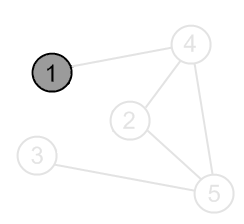 |
Mark a vertex 1 as gray. |
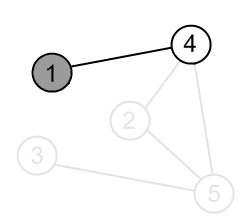 |
There is an edge (1, 4) and a vertex 4 is unvisited. Go there. |
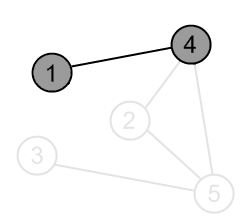 |
Mark the vertex 4 as gray. |
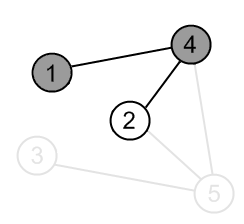 |
There is an edge (4, 2) and vertex a 2 is unvisited. Go there. |
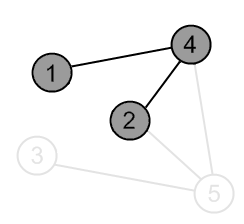 |
Mark the vertex 2 as gray. |
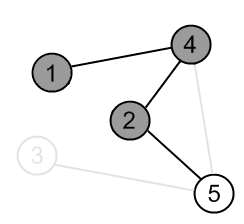 |
There is an edge (2, 5) and a vertex 5 is unvisited. Go there. |
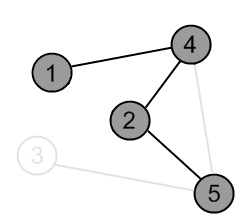 |
Mark the vertex 5 as gray. |
 |
There is an edge (5, 3) and a vertex 3 is unvisited. Go there. |
 |
Mark the vertex 3 as gray. |
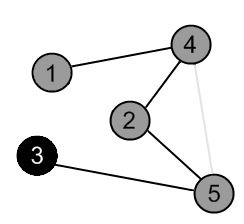 |
There are no ways to go from the vertex 3. Mark it as black and backtrack to the vertex 5. |
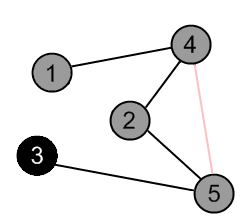 |
There is an edge (5, 4), but the vertex 4 is gray. |
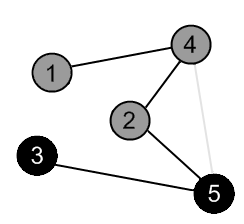 |
There are no ways to go from the vertex 5. Mark it as black and backtrack to the vertex 2. |
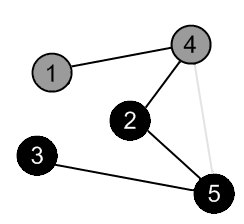 |
There are no more edges, adjacent to vertex 2. Mark it as black and backtrack to the vertex 4. |
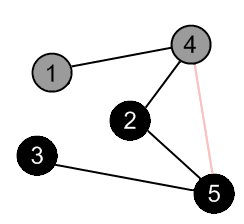 |
There is an edge (4, 5), but the vertex 5 is black. |
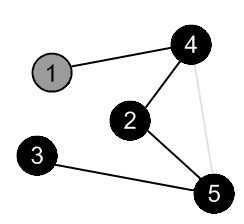 |
There are no more edges, adjacent to the vertex 4. Mark it as black and backtrack to the vertex 1. |
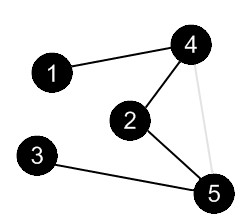 |
There are no more edges, adjacent to the vertex 1. Mark it as black. DFS is over. |
As you can see from the example, DFS doesn't go through all edges. The vertices and edges, which depth-first search has visited is a tree. This tree contains all vertices of the graph (if it is connected) and is called graph spanning tree. This tree exactly corresponds to the recursive calls of DFS.
If a graph is disconnected, DFS won't visit all of its vertices. For details, see finding connected components algorithm.
Complexity analysis
Assume that graph is connected. Depth-first search visits every vertex in the graph and checks every edge its edge. Therefore, DFS complexity is O(V + E). As it was mentioned before, if an adjacency matrix is used for a graph representation, then all edges, adjacent to a vertex can't be found efficiently, that results in O(V2) complexity. You can find strong proof of the DFS complexity issues in [1].
Code snippets
In truth the implementation stated below gives no yields. You will fill an actual use of DFS in further tutorials.
Java
public class Graph {
…
enum VertexState {
White, Gray, Black
}
public void DFS()
{
VertexState state[] = new VertexState[vertexCount];
for (int i = 0; i < vertexCount; i++)
state[i] = VertexState.White;
runDFS(0, state);
}
public void runDFS(int u, VertexState[] state)
{
state[u] = VertexState.Gray;
for (int v = 0; v < vertexCount; v++)
if (isEdge(u, v) && state[v] == VertexState.White)
runDFS(v, state);
state[u] = VertexState.Black;
}
}
C++
enum VertexState { White, Gray, Black };
…
void Graph::DFS() {
VertexState *state = new VertexState[vertexCount];
for (int i = 0; i < vertexCount; i++)
state[i] = White;
runDFS(0, state);
delete [] state;
}
void Graph::runDFS(int u, VertexState state[]) {
state[u] = Gray;
for (int v = 0; v < vertexCount; v++)
if (isEdge(u, v) && state[v] == White)
runDFS(v, state);
state[u] = Black;
}
Visualizers
Recommended books
- Cormen, Leiserson, Rivest. Introduction to algorithms. (Theory)
- Aho, Ullman, Hopcroft. Data Structures and Algorithms. (Theory)
- Robert Lafore. Data Structures and Algorithms in Java. (Practice)
- Mark Allen Weiss. Data Structures and Problem Solving Using C++. (Practice)
Three responses to "Depth-first search (DFS) for undirected graphs tutorial"
- on April 9, 2009 said:
tutorial is so good ,interactive and easy to understand
- on April 8, 2009 said:
thank you very much about DFS
- on Mar 28, 2009 said:
it was really great thanks
Contribute to AlgoList
Liked this tutorial? Please, consider making a donation. Contribute to help us keep sharing free knowledge and write new tutorials.
Every dollar helps!